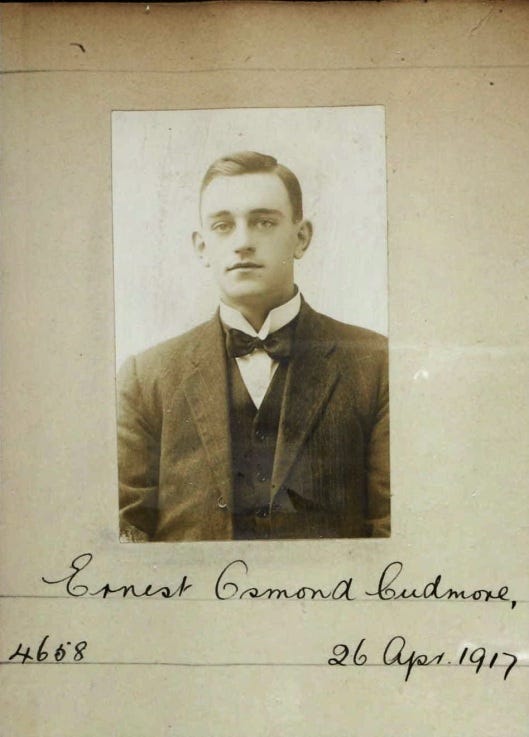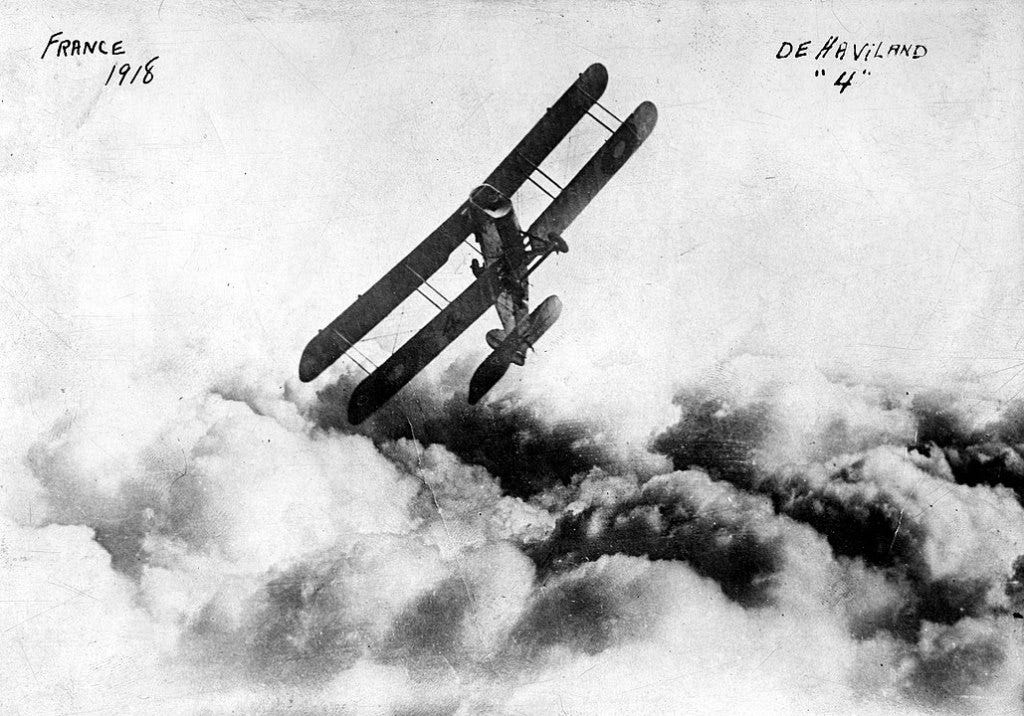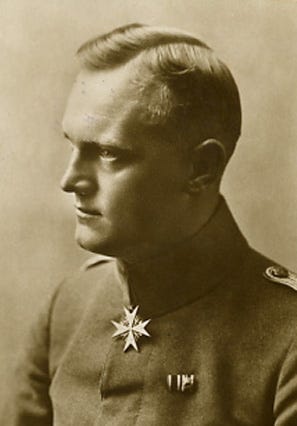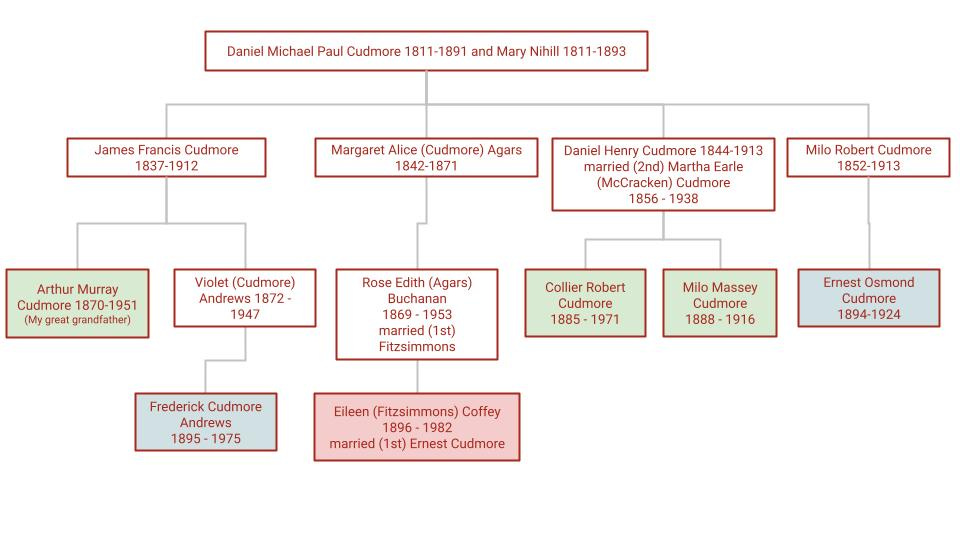They took away his wooden leg
World War 1 Royal Flying Corps: Ernest Osmond Cudmore (1894 – 1924)
In World War 1 several of my relatives served the Royal Air Force, or Royal Flying Corps, as it was called until 1918. I have written previously about Hugh Vivian Champion de Crespigny. Two more of my relatives, cousins of my paternal grandmother, also joined the Flying Corps: Frederick Cudmore Andrews and Ernest Osmund Cudmore. They both were both captured (in separate incidents). They became prisoners of war in the same camp, Holzminden in Lower Saxony.
Ernest Osmond Cudmore was born 2 July 1894 at Glen Osmond, South Australia, second of four sons of Milo Robert Cudmore (1852 – 1913) and Constance Cudmore née Alexander (1858 – 1913). Milo was the brother of James Francis Cudmore, my great great grandfather. Ernest was the cousin of my great grandfather Arthur Murray Cudmore.
When Ernest was fourteen his leg was broken in a riding accident. The bone did not set and the leg was amputated below the knee.
After the death of their parents in 1913, the four Cudmore boys were cared for by their aunt Lilian Alexander (1861 – 1931), a pioneering woman doctor, who became a noted Victorian surgeon.
Ernest took up racing motorbikes. In August 1916 he took part in a 24-hour reliability trial riding a 7 horsepower Indian in the over 600CC sidecar class.
In 1916 Ernest Cudmore sailed for England. There he gained his aviation certificate, at Bournemouth on 26 April 1917.
Until 1911 the British military forces had no have any pilot-training facilities, and most military pilots of the period were trained by members of the Royal Aero Club. By the end of World War 1, more than 6,300 military pilots had taken RAeC Aviator’s Certificates.

On 6 June 1917 Ernest Cudmore enlisted in the Royal Air Force. On 23 August 1917 he was discharged as a 3rd class air mechanic as he had received a temporary commission on probation as a 2nd lieutenant in the General List for duty with the Royal Flying Corps. He was described as 6 foot tall, keen and efficient with good military character. No descriptive marks were noted; the wooden leg was not mentioned.
His next of kin to be informed of his death or severe injury was Mrs D. H. Cudmore, Union Bank of Australia, Cornhill, London. This was probably his aunt Mrs Martha Cudmore. She too had sons fighting in the war, including Collier Robert Cudmore and Milo Massey Cudmore, cousins of Ernest.
Ernest was confirmed in his rank of 2nd Lieutenant with effect from 13 November 1917. (London Gazette 15 December 1917).
On 5 February 1918 2nd Lieutenant Ernest Cudmore and observer Sergeant Leslie Bains, both of number 25 squadron, took off on a bombing run in an Airco DH.4, a two-seat De Havilland biplane day bomber. Their mission was to bomb the railway station of the Flanders town of Deynze. They left the aerodrome at Boisdinghem, France, at 1:00 pm., flying in a small group, theirs and five other DH.4s.

At about 2.30 pm the formation was attacked by about ten or fifteen enemy aircraft, mostly the blue-nosed Albatros fighters of Jasta 36, led by the Jasta CO and Lt Heinrich Bongartz, a 28-victory ‘ace’. Royal Prussian Jagdstaffel 36, commonly abbreviated to Jasta 36, was a “hunting group” (i.e., fighter squadron) of the Luftstreitkräfte, the air arm of the Imperial German Army during World War I.
At 2:40 pm Cudmore and Bain were last seen gliding down under control until they disappeared in the clouds. They had been badly hit, apparently by fire from Bongartz; the controls and the fuel tanks were damaged and the engine failed. They crash-landed in enemy territory near Jabbeke, Belgium, about 17 kilometres west of Bruges. Cudmore and Bain set the aircraft on fire before they were captured and taken prisoners of war.
Bongartz claimed two other victims from squadron 25 that afternoon: Lt Shaw’s aircraft was hit and his observer wounded; 2nd Lt R P Pohlmann and 2/AM R Ireland were both killed when their aircraft fell in flames.

Three minutes after strafing Cudmore’s aircraft, Bongartz turned on Second Lieutenant Reggie Pohlmann’s biplane. The fire from his two Spandau machine guns cut into the DH.4 and set it on fire. One of the other 25 Squadron pilots noticed “… one of our machines burst into flames and go rapidly down and after a drop of about 2,000ft I saw the wings fold back”. There was no chance for the crew and the aircraft came down near Oudenburg, Belgium. Pohlmann was the German pilot’s 30th victory.
Reginald Pohlmann was buried by the Germans just north of Pittem, but after the war was re-interred at the Harlebeke New British Cemetery near Courtrai in Belgium. He was just 19-and a-half years old.
Ernest Cudmore was transferred to Holzminden prisoner-of-war camp. The camp held between 500 and 600 officer prisoners.There were also approximately 100–160 other ranks prisoners, designated orderlies: these men acted as servants to the officers and performed other menial tasks around the camp.
Numerous officer prisoners attempted to escape from the camp. A family story has it that Ernest tried to escape while a prisoner, so the Germans took away his wooden leg. An article in the Oamaru Mail, a New Zealand newspaper, of 22 May 1919, reporting on Holzminden mentioned Cudmore:
It was decided next day as a reprisal that all the officer-prisoners should come on parade, from colonels downward, without either hat or tunic. Then Niemeyer [the camp Kommandant] showed his true colors, his true Prussian' colors—arrogant in victory, servile in defeat.
Fearing a mutiny, he ordered the sentries to charge. The sentries, however, hated Niemeyer more than the prisoners, and the "charge" was a laughable melodramatic fiasco. The only officer to suffer was Cudmore —an Australian airman—whom hampered by the fact that he had a wooden leg, could not get into the barracks in time. He was arrested and remained three weeks "in the jug." [solitary confinement]Ernest Osmond Cudmore was repatriated to England as a prisoner of war on 13 December 1918 and demobilised from the Royal Air Force on 12 March 1919.
Lieutenant Ernest Osmond Cudmore was mentioned in dispatches gazetted 30 May 1919 for “valuable services rendered during the war”.
Ernest returned to Australia with his brother, Arthur, travelling from New York to San Fransisco across America in a Buick.
Ernest married Eileen Fitzsimmons, his first cousin once removed, on 23 December 1922 at South Yarra, Victoria.
Less than two years later, aged 30, he committed suicide.
Related posts and further reading
Thomas, A. (2020, February 27). Yorkshire warrior. Key Military. https://www.keymilitary.com/article/yorkshire-warrior : Second Lieutenant Reginald Pohlmann of the Royal Flying Corps was shot down on the same day as Ernest Cudmore
Wikitree:
Ernest Osmond Cudmore (1894 – 1924)
Eileen (Fitzsimmons) Coffey (1896 – 1982) Ernest’s wife
Martha Earle (McCracken) Cudmore (1855 – 1938) widow of Ernest’s uncle Daniel and given as Ernest’s next of kin
Frederick Cudmore Andrews (1895 – 1975) Ernest’s first cousin once removed, a fellow officer of the Royal Flying Corps who was also a prisoner of war at Holzminden
Leslie James William Bain (1889 – 1976) observer Sergeant Leslie Bains was in the plane with Ernest and was also taken prisoner of war
Reginald Peel Pohlmann (1898 – 1918) also a pilot with no. 25 squadron and shot down the same afternoon
Roy Sutton Williams Ireland (1891 – 1918) airmen in the same plane as Pohlmann and shot down 5 February 1918
Heinrich Bongartz (1892 – 1946) the German flying ace who shot down Ernest in 1918

Post first published at https://anneyoungau.wordpress.com/2024/11/22/they-took-away-his-wooden-leg/


Curious here. Are you slowly copying all or just some of your Wordpress over to Substack? I’m thinking it may be a convenient way to back up blog posts.
The bravery to be flying those bi-planes in WWI is staggering. That he’s gone by 30 is just heartbreaking.